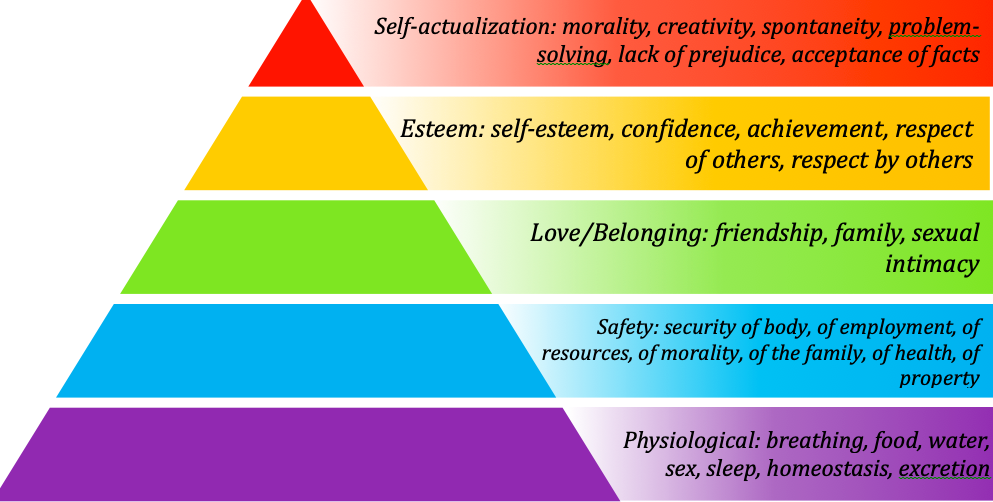This post was originally published in 2014. It has been revamped with additional research and advice for managers in 2023.
Photo by Alex Kotliarskyi on Unsplash
What, by a long shot, is the most important motivator for employees at work? Is it money, pressure, or praise?
Typically, managers believe the idea that pressure makes diamonds. The thinking is that if you want exceptional performance, you align employee objectives with end-of-year bonuses for hitting certain milestones and then employees will turn up their work ethic to reach them.
Long-held conventional wisdom on management dies hard. That’s because it’s based on gut instinct and superstition — and managerial understanding of motivation is no different. A massive 95% of managers are wrong about what the most powerful motivator is for employees at work.
Not only that, they’re thinking about employee motivation fundamentally wrong.
Maslow’s Hierarchy of Needs is Outdated
Seventy years ago, psychologist Abraham Maslow published the Hierarchy of Needs, which has dominated popular thinking on the psychology of human motivation ever since.
At the lower level of the hierarchy, Maslow’s theory holds that you have your physiological needs: food, water, and other basic needs like sleep. After that, you have safety, then love/belonging, then esteem, and finally, self-actualization in the higher levels. The pyramid shows a path of growth in an individual’s motivation as she satisfies one need and moves up to the next level.
Maslow’s hierarchy provides the basis for the kind of managerial thinking that focuses on cash bonuses as a reward for good performance. The rationale is that money is a more fundamental need in the hierarchy than passion or purpose, and therefore you can neglect the latter in favor of the former.
Another example is when managers threaten job security to drive performance. They’re attempting to hit a base need in Maslow’s hierarchy of safety and security (working conditions) in order to motivate. Seeing such needs as more fundamental in Maslow’s hierarchy than self-esteem and respect means it’s logical that threats and pressure should motivate employees to work harder.
Maslow’s hierarchy caught on immediately in the early 1940s — and perseveres today — because it’s simple to understand. But it’s outdated and facile.
Recent psychological research disproves the conventional wisdom around Maslow’s hierarchy, providing proof that it should be eradicated from how you think about your employees.
Have you seen this job ad which is considered one of the greatest ads of all time. Check that as there many hidden things behind that.
The Power of Small Wins
Whether you goal is small or big, don’t ever underestimate the power of small wins.
In a wide-ranging study of employee motivation, Harvard Business School professor Teresa Amabile and psychologist Steven Kramer asked hundreds of employees to maintain a diary chronicling their peaks and valleys in motivation at work. Amabile and Kramer eventually analyzed 12,000 diary entries in total and what they discovered was totally contrary to Maslow’s hierarchy and conventional managerial wisdom.
In fact, Amabile and Kramer talked with 600 managers about what they thought was the single most important motivator for employees at work. A shocking 95% of them got the answer wrong.
It’s not money, safety, security, or pressure that drives employees at work. It’s not the supposedly foundational needs in Maslow’s hierarchy. Their work built on psychologist Frederick Herzberg’s departure from Maslow’s theory in 1968. Herzberg posited that factors like job recognition, potential for promotion, or even passion for the work itself could motivate an individual beyond the satisfaction of her or his basic needs.
According to Amabile and Kramer, the most important motivator for employees at work is “the power of small wins”: employees are highly productive and driven to do their best work when they feel as if they’re making progress every day toward a meaningful goal.
A New Theory of Motivation for High Performance
Non-hierarchical thinking about employee needs is important for your whole team — even your best performers.
In a recent study by psychologist Susan David of highly engaged employees at work, David asked people what made them so engaged and excited about their work.
Ninety-six percent of the employees didn’t mention pay at all. Instead, what David found dovetailed with Amabile and Kramer’s discovery. In describing their motivations at work, highly engaged employees “highlighted feeling autonomous and empowered, and a sense of belonging on their teams.”
Evidence continues to build. A 2019 Harvard Business Review study found that one of the top reasons why good employees begin to fail is a belief in their lack of self-efficacy (that they aren’t able to complete their work). Good managers will work with these employees to rebuild their self-confidence. One of the easiest ways to boost confidence is through securing a series of wins.
Here are a few efficient ways to help your employees achieve these wins, regardless of their current level of success.
- Create a list of productivity goals on a daily or weekly basis. (Start simple. Over time, they can become more complex once employees capture low-hanging fruit.)
- Break down larger tasks into manageable pieces — and incorporate these as individual tasks into your productivity goals. (This will make the future seem less daunting — and the day-to-day more achievable.)
- If the employee feels as though he or she will have to invest more time and energy than is possible in a task, express confidence that their additional hard work will help them succeed. (This can help them take the first step.)
Of course, incorporating simple productivity fixes like iDoneThis daily check-ins will also help you along the way. It’s time to test these new theories of motivation in 2023.




